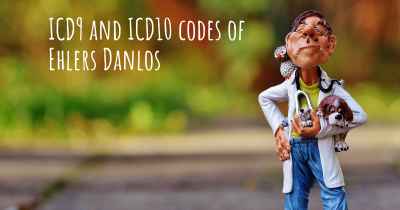How is Ehlers Danlos diagnosed?
See how Ehlers Danlos is diagnosed. Which specialists are essential to meet, what tests are needed and other useful information for the diagnosis of Ehlers Danlos

How is Ehlers Danlos diagnosed?
Ehlers Danlos Syndrome (EDS) is a group of genetic disorders that affect the connective tissues in the body. It is characterized by joint hypermobility, skin hyperextensibility, and tissue fragility. Diagnosing EDS can be challenging due to its wide range of symptoms and the overlap with other conditions. However, there are several key steps and diagnostic criteria that healthcare professionals use to identify and diagnose EDS.
Medical History and Physical Examination
The first step in diagnosing EDS is a thorough medical history and physical examination. The healthcare provider will ask about the patient's symptoms, family history, and any previous medical conditions. They will also perform a detailed physical examination to assess joint flexibility, skin elasticity, and other potential signs of EDS.
Diagnostic Criteria
The diagnosis of EDS is based on specific diagnostic criteria established by the International Consortium on Ehlers-Danlos Syndromes (ICED). These criteria help classify the different types of EDS and guide healthcare professionals in making an accurate diagnosis. The most recent classification is the 2017 International Classification of the Ehlers-Danlos Syndromes.
The diagnostic criteria for EDS include:
- Generalized joint hypermobility: The presence of joint hypermobility is a key feature of EDS. It is assessed using the Beighton score, which evaluates the range of motion in specific joints.
- Skin involvement: EDS can affect the skin, leading to hyperextensibility, easy bruising, and poor wound healing.
- Family history: A family history of EDS or similar connective tissue disorders can increase the suspicion of EDS.
- Additional features: Depending on the specific type of EDS suspected, additional features such as vascular complications, organ involvement, or specific genetic mutations may be considered.
Genetic Testing
Genetic testing plays a crucial role in diagnosing EDS. It can help identify specific genetic mutations associated with different types of EDS. However, it is important to note that not all types of EDS have a known genetic cause, and genetic testing may not always be conclusive.
The types of genetic testing used in EDS diagnosis include:
- Collagen gene sequencing: This test analyzes specific genes responsible for producing collagen, the main protein in connective tissues. Mutations in these genes can lead to various types of EDS.
- Next-generation sequencing: This advanced technique allows for the simultaneous analysis of multiple genes associated with EDS, increasing the chances of identifying a genetic mutation.
- Other genetic tests: Depending on the suspected type of EDS, additional genetic tests may be performed to detect specific mutations or abnormalities.
Specialized Consultations
Due to the complexity of EDS, specialized consultations with various healthcare professionals may be necessary for a comprehensive diagnosis. These may include geneticists, rheumatologists, dermatologists, orthopedic surgeons, and other specialists who can evaluate specific symptoms and provide expert opinions.
Differential Diagnosis
EDS shares symptoms with other connective tissue disorders and genetic conditions, making differential diagnosis essential. The healthcare provider will consider other conditions that may mimic EDS and perform additional tests to rule them out. Some conditions that may be considered in the differential diagnosis include Marfan syndrome, osteogenesis imperfecta, and other collagen-related disorders.
Conclusion
Diagnosing Ehlers Danlos Syndrome involves a combination of medical history, physical examination, diagnostic criteria, genetic testing, specialized consultations, and ruling out other conditions. It is important to consult with a healthcare professional experienced in EDS to ensure an accurate diagnosis and appropriate management of the condition.
Posted Apr 11, 2017 by Montana 1670
Posted May 10, 2017 by stairphobe 3070
One of the most important things is to have a family history at hand when you go to a Rheumatologist/Geneticist. Since there isn't a genetic test for EDS Hypermobility, family history and your own history is what the Geneticist will base their diagnosis on.
Posted May 25, 2017 by Maria 2051
Posted May 26, 2017 by Stephanie 800
Posted May 27, 2017 by Jude 2050
Posted May 27, 2017 by Ashley 950
Posted May 28, 2017 by Celi 2000
Posted May 31, 2017 by KathrynOConnor 2200
Posted Jun 4, 2017 by Richelle 1750
Posted Sep 27, 2017 by Lbond94 4100
Posted Oct 6, 2017 by Sasha 2050
Posted Oct 7, 2017 by Sharon 7050
Posted Oct 25, 2017 by Dolores 3050
It should involve reports from many Specialists depending on what the patient is presenting with of course Rheumatologist / Geneticist / Dermatologist / Cardiologist / Opthalmologist / Neurologist / Hematologist / Internist / Physiatrist
It should begin with a Geneticist that specializes in Connective Tissue Disorders
Genetic testing up front
Genetic counselling - not just a geneticist that says ' show me your tricks' and you need to perform like a circus dog. Only to be sore days later.
These doctors must all have knowledge that not ALL EDS patients are hypermobile, have stretchy skin, or are tall and lean. A multidisciplinary approach to diagnosis is necessary for all types.
Testing for the common cardiac issues / genetic markers / structural differences / full medical history that includes symptoms and abilities past and present / Full family medical history / physical examination / that doesnt just involve the 'party tricks'
Sometimes the patient is looking for a simple answer to a question and not necessarily a diagnosis or a new label. Most important of all in this process, is a strong General Practitioner that is allowed the extra time needed to coordinate the protocol of care recomended after a diagnosis has been made. Without that, things can be a struggle.
The patient is in the drivers seat in their care but you have to be able to trust in the skill and training and expertise of your medical team. If you can't freely talk to a doctor and you don't feel heard, try and talk to them about that. If you still don't feel heard, find another doctor. This however is easier said than done. Doctors deserve respect, Patients also deserve respect. You might know more about this illness than the doctors you meet along the way, but you are the patient and at some point you MUST trust your doctor. ALWAYS research in peer reviewed articles, find support systems around you, don't overwhelm in the moment but prepare for doctor visits, and if you know something is wrong (even if tests and assessments say otherwise) push till you are heard. Do that in a respectful calm way and bring someone with you to appointments that can speak and ask questions when you can't.
A team is what EDS'ers need, but the proper team that you choose and feel comfortable with. Know what each Specialist does and what they treat, make sure your referrals are done and the content of the referrals are appropriate to the reason for the appointment
Posted May 11, 2018 by Izzy 600
Posted May 26, 2018 by Danielle 1500
Posted Jul 6, 2018 by Estefania 1150
Posted Mar 21, 2019 by pianocat_61 1400
Posted Sep 29, 2019 by Amy 13500
Posted Mar 10, 2020 by MegTheMariner 1870
Many doctors are not knowledgeable about EDS or hesitant to diagnose because it is rare.
Posted May 12, 2020 by Alex 3551
Posted Nov 19, 2021 by NuNu 2550
Posted Nov 28, 2022 by Taiy rinaldi-bull 600
Posted Mar 25, 2017 by Paula Lopez 1151
Several grid where criteria are used as the basis for the diagnosis.
Posted Aug 16, 2017 by Apolline 1205
At the level of the clinic, the score of Beighton is still the most used. It measures instability of multiple. But it is clear that some physicians use it for the "now" so that it should be used, taking into account the patient's history. this is not because we do not know to put his hands on the ground for over 50 years, it has never been known to do that...
We will also consider the personal history in terms of sprains, dislocations, subluxations, tendonitis...
Posted Aug 17, 2017 by Sandrine 1790
Diagnosed after wandering medical late
We are looking for a hyperlaxité, skin fragile and thin, hyper accousie (or hypo) , extreme fatigue , bowel problems (constipation / diarrhea ), bleeding, easy and abundant, surgery is ineffective and healing is long and difficult, migraine, spontaneous contraction of the muscles
Posted Aug 30, 2017 by Ehos 1050
If you need time and iniciátivas to discover is syndrome. Normally one should look for a geneticist, you can do skin biopsies to detect certain types of colágenos disabled or examinations that may lead to complete such sindorme.
Posted Aug 30, 2017 by Kayla Rarine 2000








